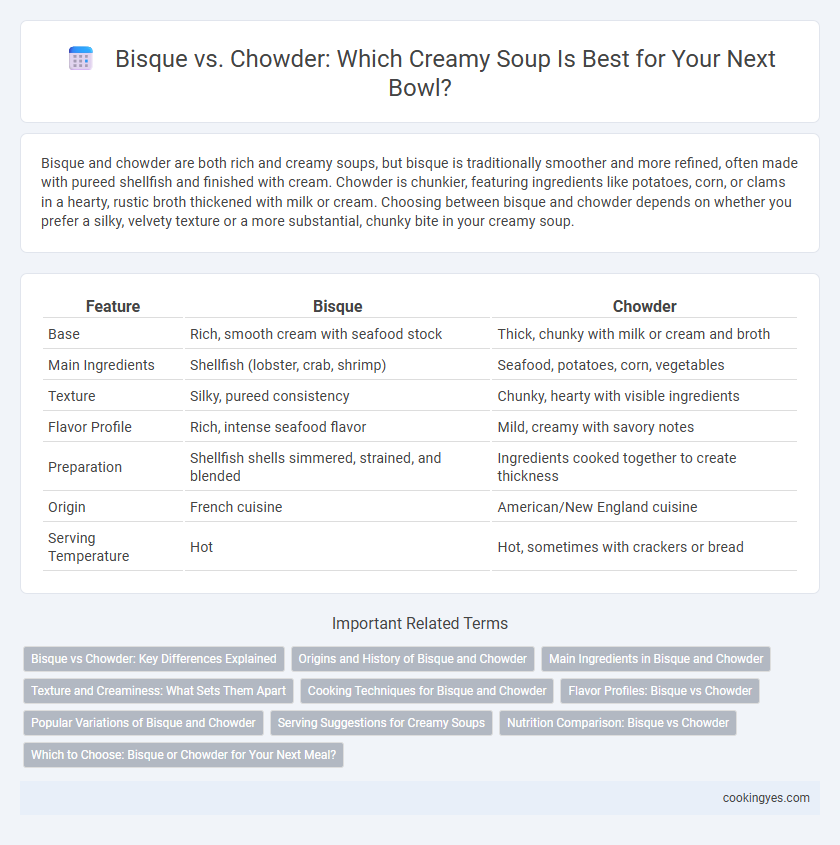Bisque and chowder are both rich and creamy soups, but bisque is traditionally smoother and more refined, often made with pureed shellfish and finished with cream. Chowder is chunkier, featuring ingredients like potatoes, corn, or clams in a hearty, rustic broth thickened with milk or cream. Choosing between bisque and chowder depends on whether you prefer a silky, velvety texture or a more substantial, chunky bite in your creamy soup.
Table of Comparison
| Feature | Bisque | Chowder |
|---|---|---|
| Base | Rich, smooth cream with seafood stock | Thick, chunky with milk or cream and broth |
| Main Ingredients | Shellfish (lobster, crab, shrimp) | Seafood, potatoes, corn, vegetables |
| Texture | Silky, pureed consistency | Chunky, hearty with visible ingredients |
| Flavor Profile | Rich, intense seafood flavor | Mild, creamy with savory notes |
| Preparation | Shellfish shells simmered, strained, and blended | Ingredients cooked together to create thickness |
| Origin | French cuisine | American/New England cuisine |
| Serving Temperature | Hot | Hot, sometimes with crackers or bread |
Bisque vs Chowder: Key Differences Explained
Bisque and chowder are both rich, creamy soups but differ significantly in ingredients and texture. Bisque is a smooth, velvety soup traditionally made from pureed shellfish like lobster or crab, often finished with cream and sherry for a refined taste. Chowder is chunkier, featuring hearty ingredients such as potatoes, clams, or corn, with a milk or cream-based broth that creates a thicker, more rustic consistency.
Origins and History of Bisque and Chowder
Bisque originated in 17th-century France as a rich, creamy soup traditionally made from shellfish, particularly lobster, crab, or shrimp, with a smooth texture achieved by blending the ingredients. Chowder, rooted in New England, United States during the 18th century, evolved as a hearty, chunky dish typically featuring clams, potatoes, and milk or cream, reflecting its coastal fishing community origins. Both soups highlight regional ingredients and culinary traditions, with bisque emphasizing refinement and chowder focusing on rustic, comforting flavors.
Main Ingredients in Bisque and Chowder
Bisques are traditionally made with shellfish like lobster, crab, or shrimp, combined with cream and a smooth, strained base for a rich, velvety texture. Chowders primarily include chunky ingredients such as potatoes, onions, and often clams or corn, with a thicker, heartier consistency typically achieved through milk or cream. Both soups emphasize different textures and ingredient profiles, with bisques focusing on pureed seafood flavors and chowders highlighting chunky, vegetable-rich mixtures.
Texture and Creaminess: What Sets Them Apart
Bisque features a smooth, velvety texture achieved by pureeing shellfish with cream, creating a rich and luxurious mouthfeel. Chowder offers a chunkier consistency with a hearty blend of diced vegetables, potatoes, and seafood or meat, often thickened with milk or cream for a creamy yet textured experience. The primary difference lies in bisque's refined smoothness versus chowder's robust, chunky creaminess.
Cooking Techniques for Bisque and Chowder
Bisque involves simmering shellfish shells to extract rich, concentrated flavors followed by blending and straining for a smooth, velvety texture. Chowder uses a slower cooking process with diced potatoes and chunky ingredients, often thickened with cream or milk to create a hearty, creamy consistency. The key cooking technique for bisque emphasizes pureeing and straining, while chowder maintains texture through gentle simmering and chunky components.
Flavor Profiles: Bisque vs Chowder
Bisque offers a rich, smooth texture with a concentrated seafood flavor often enhanced by cream and brandy, delivering a luxurious and velvety taste experience. Chowder typically features chunkier ingredients such as potatoes, corn, and clams, creating a heartier, more rustic flavor profile with a thicker, creamy base. The bisque emphasizes refined seafood notes, while chowder balances creaminess with savory, chunky textures that highlight comforting, earthy flavors.
Popular Variations of Bisque and Chowder
Popular variations of bisque include lobster bisque, crab bisque, and shrimp bisque, known for their smooth texture and rich, seafood-infused flavor. Chowder commonly appears as New England clam chowder, corn chowder, and potato chowder, characterized by a chunky consistency with ingredients like clams, corn, potatoes, and cream. Both soups offer creamy bases but differ in texture and ingredient composition, with bisque emphasizing pureed shellfish and chowder featuring hearty vegetable and seafood chunks.
Serving Suggestions for Creamy Soups
Bisque is best served hot, often accompanied by a garnish of fresh herbs or a swirl of cream to enhance its rich, velvety texture. Chowder pairs well with crusty bread or oyster crackers, providing a hearty complement to its chunky ingredients and creamy base. Both soups benefit from a side of crisp salad to balance their richness and create a well-rounded meal.
Nutrition Comparison: Bisque vs Chowder
Bisque, typically made from pureed shellfish and cream, tends to be richer in protein and omega-3 fatty acids, supporting heart health and muscle maintenance. Chowder often contains diced potatoes, corn, and milk or cream, offering higher fiber and carbohydrate content along with vitamins C and B6. Both soups provide essential nutrients, but bisque is generally more calorie-dense with a smoother texture, while chowder delivers greater fiber and antioxidant benefits from its vegetable ingredients.
Which to Choose: Bisque or Chowder for Your Next Meal?
Bisque offers a smooth, velvety texture made from pureed shellfish and cream, ideal for a rich and elegant dining experience. Chowder contains chunky ingredients like potatoes, corn, or clams in a creamy, hearty broth, perfect for a comforting and filling meal. Choose bisque for sophistication and chowder for rustic heartiness in your next creamy soup.
Bisque vs Chowder for creamy soups Infographic

 cookingyes.com
cookingyes.com